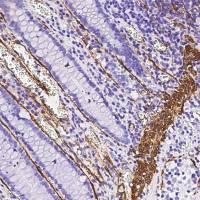It has long been apparent that the three cytoskeletal systems of eukaryotic cells, microtubules, f-actin, and intermediate filaments, act in a cooperative fashion, both to achieve their characteristic distributions within cells (1 –3 ), and to execute a variety of complex cellular phenomena (4 ). However, defining the nature of interactions between the different systems has proven difficult. These difficulties stem from several different features of the three cytoskeletal systems. The filamentous nature of the systems makes it difficult to apply standard biochemical approaches, since most such approaches cannot distinguish between specific interactions and those that result from fortuitous entanglement. Similarly, because all three systems are very abundant in the typical cell, and because all three systems are to greater or lesser degrees dynamic, simultaneous imaging of the different systems in living cells may be less than informative. Further, in most cell types, it is difficult, if not impossible to adequately preserve all three systems in the same preparation using standard immunofluorescence approaches. For example, in Xenopus oocytes and eggs, entirely different fixation protocols are required for visualization of microtubules (5 ), f-actin (6 ), and intermediate filaments (7 ).






